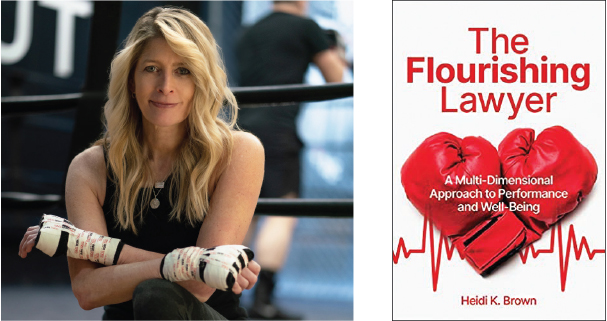
Closing


“Flourishing” in the Field of Law
What does it mean to be a “flourishing lawyer”?
In studying applied positive psychology with the field’s founder, Martin E.P. Seligman, I read his book, titled Flourish. In my studies, I dove more deeply into the concept of flourishing, aspiring to apply it to the legal profession. Flourishing is not just feeling good, which psychologists call “hedonic well-being,” but includes “eudaimonia,” a Greek term that means “functioning well.” Flourishing isn’t just smiling all the time and having a good day. We all know that’s unrealistic. To function well, we set up cognitive, emotional, and physical systems to remind us that, when we do encounter stress or anxiety or fear, we remember that we’ve been through situations like that before and we are equipped with resources to tackle each problem. We learn to trust our systems and ride out the rise and fall of stress symptoms to get through inevitable rough times. Just as athletes and performers train in multiple dimensions before they step into the performance arena, we can do the same.

The physical dimension seems to be one of the most ignored by lawyers, so my book starts with it. Throughout two decades of practicing law, my anxiety and fear manifested physically, and not just in feeling stressed. I have a robust blushing response and my body reacts to stress by trying to get small: I instinctively hunch my shoulders and cross my arms, I lose my breath, my heart races, and I get hot and sweaty. We all experience one component of the fight, flight, or freeze response. If we become more “somatically intelligent” as lawyers and learn more about our bodies, and how to make subtle changes in posture and stance, we can learn, like athletes or performers, to control some of our individual physical reactions. In doing so, we learn to modulate our emotions and enhance our cognitive performance. Dr. John Ratey wrote an amazing book called Spark about how moving our bodies fires up our brains. Getting to know my physical self (including through boxing lessons) taught me how to make adjustments in how my body responds to stress, rein in unhelpful emotions, and cultivate helpful ones. As lawyers, we use our brains to solve problems, but if we’re not moving our bodies, we’re missing out on a key technique that could help us think better.
What are some other ways lawyers can use self-awareness to enhance performance?
Lawyers must demonstrate “character and fitness” to practice law, but often it seems we view those terms as mere boxes we check on a form. In the book, I explore character as something we can and should cultivate over the life of our careers rather than verify at one specific point in time. The Values and Action Institute on Character offers a scientifically validated assessment (viacharacter.org) that identifies and ranks our character strengths from 1 to 24, offering us a vocabulary around our strengths. The rankings identify our “signature strengths” based on three Es: our top strengths energize, excite, and come easily for us. Our lower strengths aren’t necessarily weaknesses; we might use them just fine, but doing so might sap our energy. Knowing our strengths helps us become more effective performers, to identify Hey, I am really excited to do this type of work, but another type of work really drains me. For example, during the pandemic, I realized Zoom meetings really deplete me, so I started scheduling all my Zoom meetings on the same day so I could gear up for that type of arduous day, be mentally prepared, and know how to wind down from it. I kept my other days freer so I could maximize use of my higher strengths. I suggest junior attorneys and supervising attorneys cultivate a shared vocabulary around strengths, to enhance the productivity and enjoyment of their work.
You add the “creative dimension,” as another component of lawyer well-being. In your book, you mention journaling, creative writing, and photographing street art as your creative outlets. But what other tactics are there and how do they work?
Often, legal solutions are not that obvious. Even though it might seem like the answer is supposed to be clear in the statute, case, regulations or contract, many times it’s not. Good lawyers aren’t afraid to get creative, even if it feels messy or awkward at first. For lawyers trying to solve a problem, or people trying to negotiate a deal and trying to get through an impasse, it can help to take a break and tap into our creative sides. Experts indicate that we don’t need to be “real” artists to reap well-being benefits and solution-generating benefits from creative pursuits. And creative exploration doesn’t have to take up a lot of time. We could take a half hour to look at a book of art, visit an art gallery on the weekend, mess around with a musical instrument or play around with paint or clay. The research shows that creativity helps with problem solving because it fosters divergent instead of convergent thinking. So, by tapping into our creative brain, a whole host of different options will start appearing in our minds. Instead of narrowing in on the thing we’re so focused on, we’re able to see the bigger picture, which I think is so helpful as a lawyer.